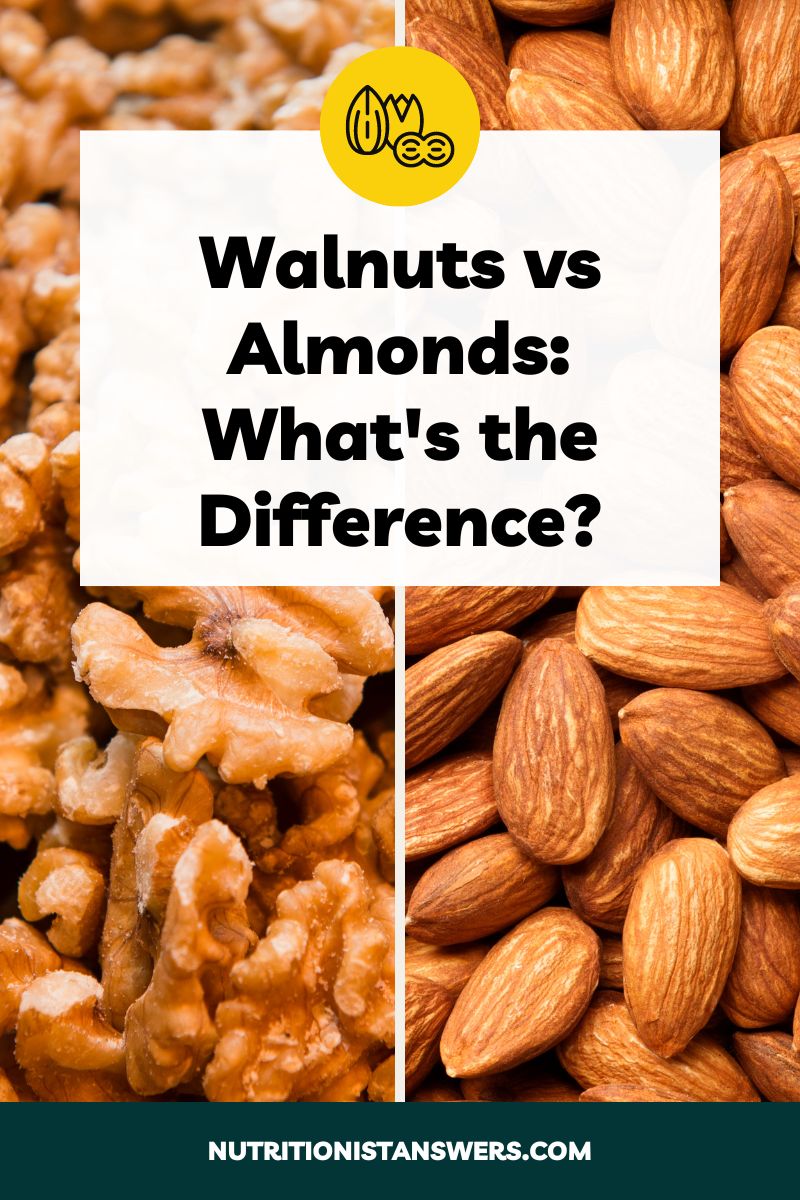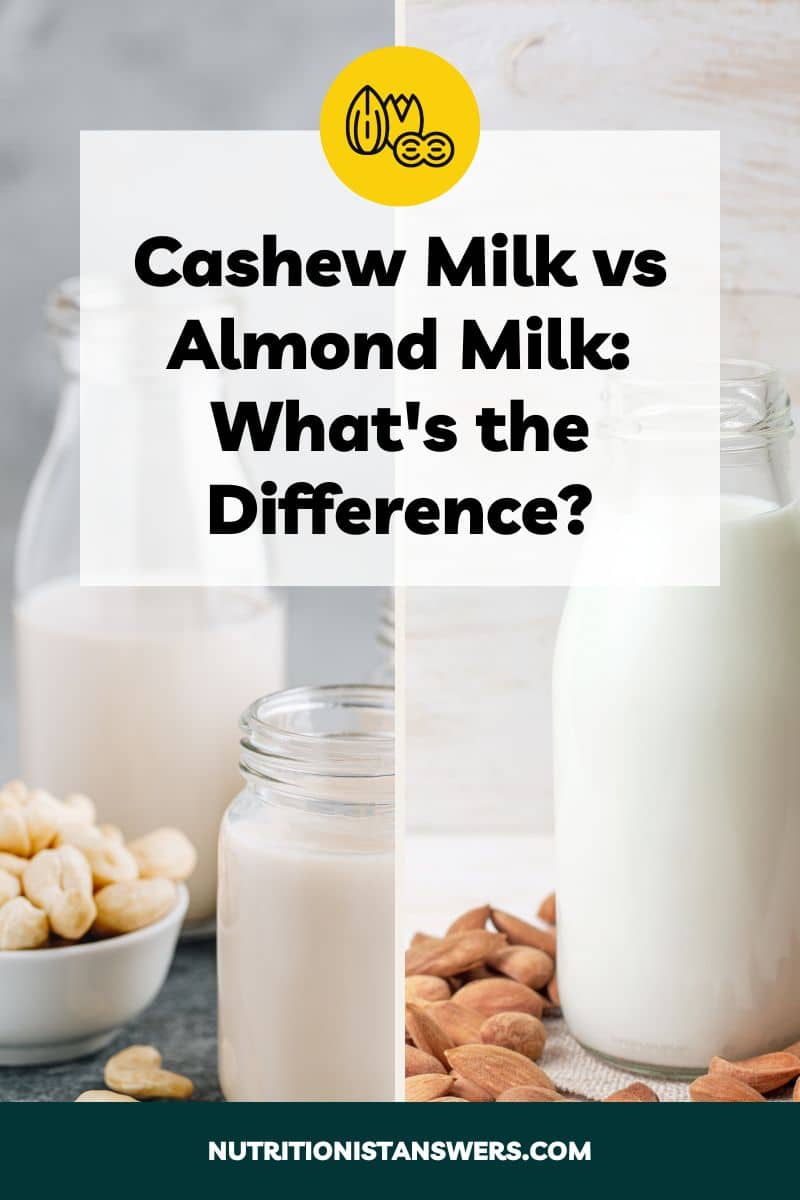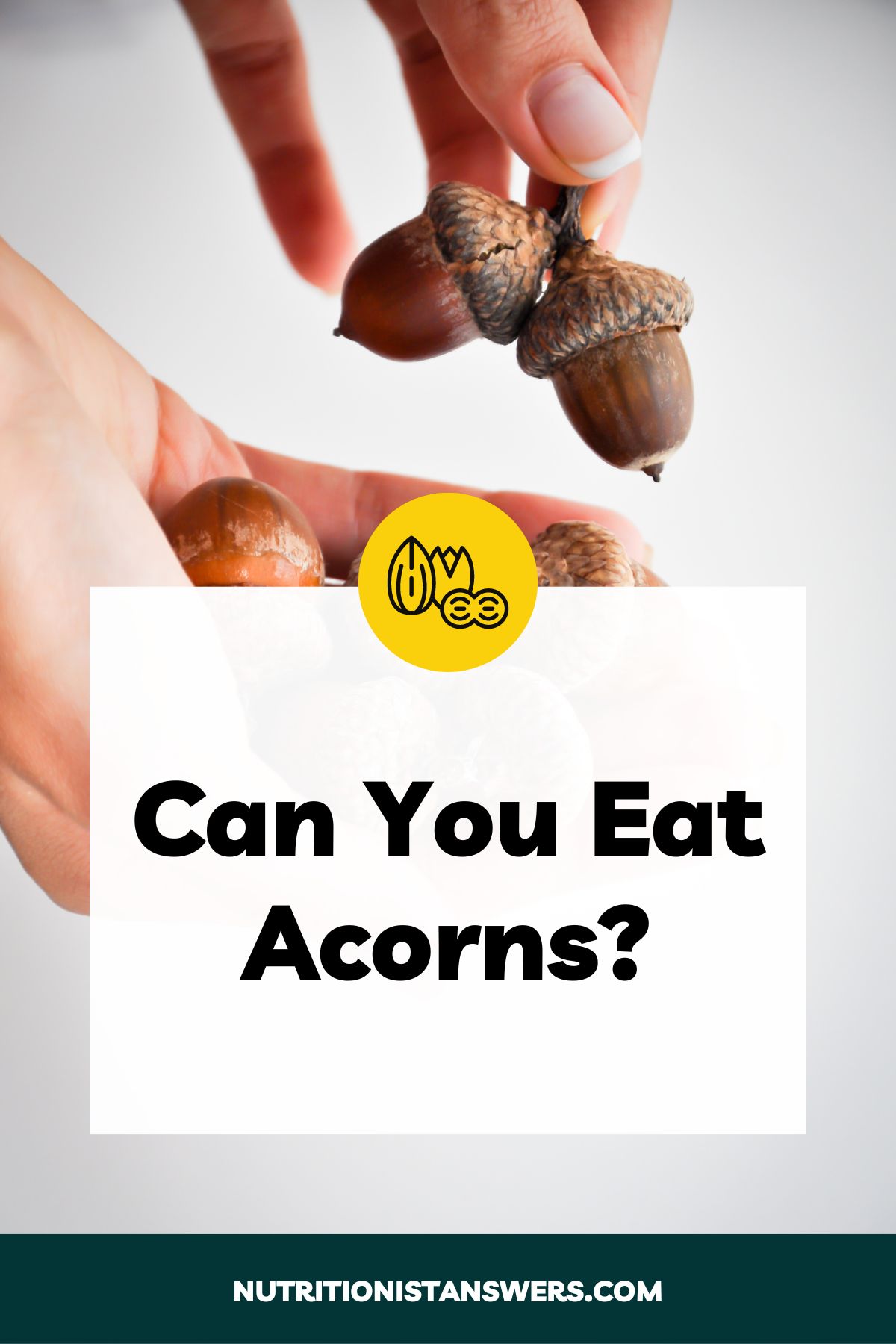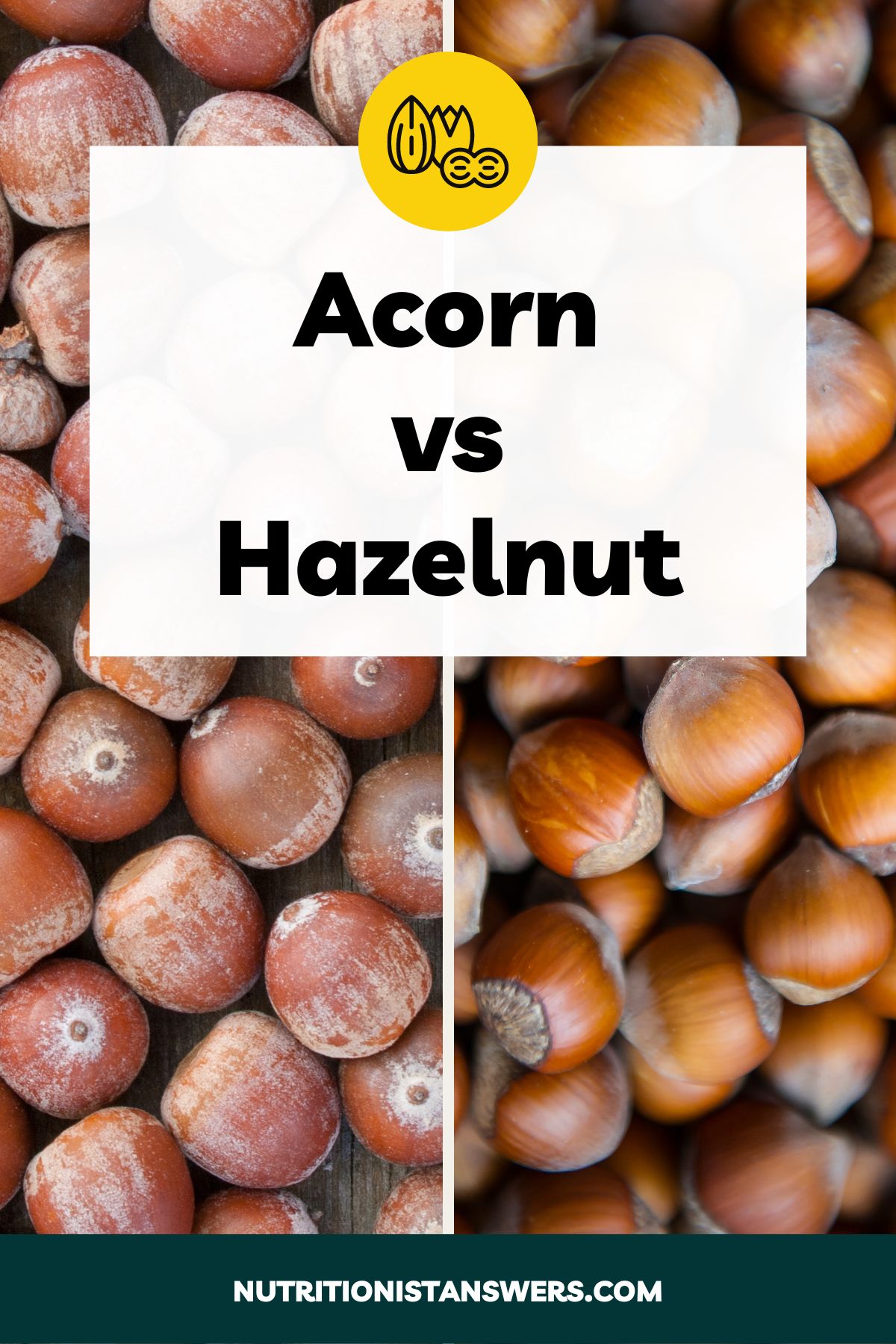When it comes to nuts, almonds and walnuts are two of the most popular and widely consumed varieties.
Both offer a range of health benefits and are great sources of healthy fats, fiber, and protein. However, there are some notable differences in flavor, texture, and cost.
In this article, we’ll explore the similarities and differences between walnuts and almonds, in terms of nutrition, taste, available forms, prices, and uses.
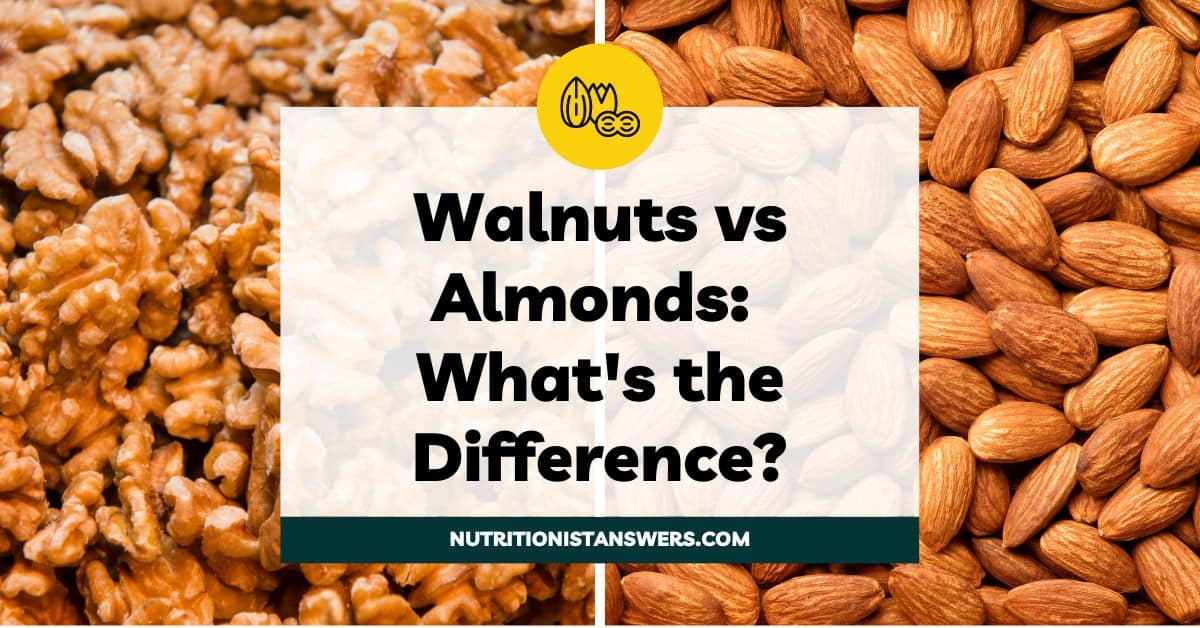
Please note that this article contains affiliate links. If you click one of these links and make a purchase, we may earn a commission. As an Amazon Associate, we earn from qualifying purchases.
What are walnuts?
Walnuts are a type of tree nut. There are two main types: English walnuts (originally called Persian walnuts), which originated in Iran, and black walnuts which are native to North America (1).
Both types of walnuts have a hard, oval-shaped shell. When the shell is cracked open, it reveals a two-lobed, cream-colored edible nut kernel that looks similar to a human brain.
English walnuts taste mild and nutty, with a hint of sweetness. Compared to other nuts, they are softer and easier to chew.
Black walnuts are known for their much bolder, earthier flavor, and their extremely hard, difficult-to-crack shells.
English walnuts are very popular and can be found at grocery stores. Black walnuts can be harder to find, but are sometimes available in small quantities in the baking aisle and can also be purchased online.
Walnuts make an excellent snack on their own and can also add texture and flavor to salads, baked goods, and other dishes.
What are almonds?
Almonds are the nuts produced by almond trees (Prunus dulcis), which are native to Central Asia (2).
They have a hard, teardrop-shaped outer shell that can be cracked and removed to reveal the edible nut kernel inside, which is creamy white and covered by a thin brown skin.
Almonds are known for their crunchy texture and delicate, nutty flavor. They are slightly sweet with just a hint of bitterness.
You can find almonds in many different forms, including whole, sliced, and slivered. They are typically found in the baking aisle, snack aisle, or bulk foods section of grocery stores.
Almonds can be used in a variety of ways — as a snack, in salads, in baking, or processed into almond milk or butter.
Walnuts vs almonds
Almonds have a mild, slightly sweet flavor with a subtle nuttiness, while walnuts have a richer, more distinctive nutty flavor that can be slightly bitter or earthy depending on the variety.
Both nuts are high in fat, low in carbohydrates, and provide a small amount of protein and fiber. They’re also rich in minerals, such as magnesium, copper, and manganese.
Walnuts are higher in calories and fat and offer higher amounts of thiamin, vitamin B6, and folate.
Almonds are slightly higher in protein and carbs, and are a rich source of vitamin E, providing almost 50% of the DV per serving.
Here’s a more detailed review of how they compare in flavor, nutrition, available forms, prices, and recommended uses:
Flavor comparison
English walnuts have a rich, slightly bitter nutty taste that complements a variety of foods, while Black walnuts have a bolder, earthier flavor that can be overpowering if used in large amounts.
Walnuts are softer in texture, but slightly more bitter than almonds.
Almonds have a slightly sweet, pleasant nutty flavor. They are slightly firmer than walnuts and become even crunchier after roasting.
Walnuts and almonds pair well with similar flavors such as warm spices, honey, vanilla, and chocolate.
Nutrition comparison
Here’s a side-by-side comparison of the calorie and macronutrient content of walnuts and almonds, based on a 1-ounce (28-gram) serving size (3, 4):
| Nutrient | Walnuts, unroasted (28g) | Almonds, unroasted (28g) |
| Calories | 185 | 164 |
| Protein | 4 grams | 6 grams |
| Fat | 19 grams | 14 grams |
| Saturated fat | 2 grams | 1 gram |
| Monounsaturated fat | 3 grams | 9 grams |
| Polyunsaturated fat | 13 grams | 4 grams |
| Carbohydrates | 4 grams | 6 grams |
| Fiber | 1.9 grams | 3.5 grams |
Calories
Walnuts are 13% higher in calories than almonds due to their higher fat content.
A 1-ounce (28-gram) serving of walnuts provides 185 calories, while the same serving of almonds offers 164 calories.
Protein
Almonds have over 50% more protein per serving than walnuts (6 grams vs 4 grams, respectively.).
If you’re trying to include more protein in your diet, almonds would be the better nut choice.
Fat
Both walnuts and almonds are high in fat, but walnuts provide about 35% more fat per serving than almonds.
A 1-ounce (28-gram) serving of walnuts contains 19 grams of fat, while an equal serving of almonds contains 14 grams of fat.
The extra fat makes walnuts softer and gives them a more buttery mouthfeel, compared to almonds.
While both almonds and walnuts are low in saturated fat, almonds contain a higher proportion of heart-healthy monounsaturated fats.
Walnuts are especially rich in polyunsaturated fats, including almost 3 grams of alpha-linolenic acid (ALA), a type of omega-3 fat (3).
If you’re following a high-fat, low-carbohydrate diet, like keto, walnuts are a slightly better choice than almonds.
Carbohydrates
Like most nuts, walnuts and almonds are fairly low in carbohydrates.
Almonds have slightly more carbohydrates than walnuts, providing 6 grams per serving compared to the 4 grams found in walnuts.
If you are following a low-FODMAP diet, walnuts are the better choice. A traditional one-ounce serving of walnuts is low-FODMAP, while almonds are only low-FODMAP in small portions (up to 10 nuts.)
Vitamins and minerals
Here’s an overview of the vitamin and mineral content of walnuts and almonds, based on a 1-ounce (28-gram) serving (3, 4):
| Nutrient | Walnuts, unroasted (28g) | Almonds, unroasted (28g) |
| Vitamin A | 1 mcg RAE (<1% DV) | 0 mcg RAE (0% DV) |
| Vitamin B1 (Thiamin) | 0.1 mg (8% DV) | 0.06 mg (5% DV) |
| Vitamin B2 (Riboflavin) | 0.04 mg (3% DV) | 0.3 mg (23% DV) |
| Vitamin B3 (Niacin) | 0.3 mg (2% DV) | 1 mg (6% DV) |
| Vitamin B5 (Pantothenic acid) | 0.2 mg (4% DV) | 0.1 mg (2% DV) |
| Vitamin B6 (Pyridoxine) | 0.15 mg (9% DV) | 0.04 mg (2% DV) |
| Vitamin B9 (Folate) | 28 mcg (7% DV) | 13 mcg (3% DV) |
| Vitamin B12 (Cobalamin) | 0 mcg (0% DV) | 0 mcg (0% DV) |
| Vitamin C | 0.4 mg (<1% DV) | 0 mg (0% DV) |
| Vitamin D | 0 mcg (0% DV) | 0 mcg (0% DV) |
| Vitamin E | 0.4 mg (3% DV) | 7 mg (47% DV) |
| Vitamin K | 1 mcg (1% DV) | 0 mcg (0% DV) |
| Choline | 11 mg (2% DV) | 15 mg (3% DV) |
| Sodium | 0.6 mg (<1% DV) | 0.3 mg (<1% DV) |
| Potassium | 125 mg (3% DV) | 208 mg (4% DV) |
| Calcium | 28 mg (2% DV) | 76 mg (6% DV) |
| Phosphorus | 98 mg (8% DV) | 136 mg (11% DV) |
| Magnesium | 45 mg (11% DV) | 77 mg (18% DV) |
| Iron | 0.8 mg (4% DV) | 1.1 mg (6% DV) |
| Zinc | 0.9 mg (8% DV) | 0.9 mg (8% DV) |
| Copper | 0.45 mg (50% DV) | 0.29 mg (32% DV) |
| Manganese | 1 mg (43% DV) | 0.6 mg (26% DV) |
| Selenium | 1.4 mcg (3% DV) | 1.2 mcg (2% DV) |
Walnuts provide a good amount of many B vitamins, including thiamin, vitamin B6, and folate.
Almonds, on the other hand, are especially high in riboflavin (vitamin B2), providing 23% of the Daily Value (DV). They also provide nearly half of your daily needs for vitamin E.
Both almonds and walnuts are rich in minerals. Walnuts are higher in copper, and manganese, while almonds offer more calcium, phosphorus, and magnesium.
Available forms
1. Whole (walnuts and almonds)
Almonds and walnuts are typically sold whole with their shells removed.
You can find them easily at most supermarkets and health food stores, in the baking aisle, bulk foods section, or snack aisle. They can also be purchased in bulk online from Nuts.com.
Buying whole nuts and chopping them at home is usually less expensive than buying pre-chopped or sliced nuts.
2. Pre-cut (walnuts and almonds)
Pre-cut almonds and walnuts are a hassle-free option that can be eaten or used in recipes without any preparation.
You can find them in the baking aisle or bulk foods section of the grocery store. They are also available for purchase online.
Walnuts are available chopped, while almonds are sold sliced or slivered (peeled and cut into tiny sticks).
3. Flour (walnuts and almonds)
Nut flours made from walnuts or almonds are popular gluten-free flour options. They’re used to replace wheat flour in baked goods, breaded meats, and more.
Almond flour is usually located in the baking aisle or bulk foods section of most supermarkets, and can also be purchased online.
Walnut flour is less popular than almond flour but can also be found at many supermarkets and health food stores.
4. Butters (walnuts and almonds)
Almond butter is a popular alternative to peanut butter and can be found at more grocery stores or online.
Walnut butter is also available, but tends to be expensive since walnuts are a higher-priced nut. You’re most likely to find it online or at health food stores.
Sun & Seed is a popular brand that sells walnut butter on Amazon.
5. Oil (walnuts and almonds)
Roasted walnut oil is available from brands like La Tourangelle and can be used in cooking.
It has a rich, nutty taste, making it ideal for dishes that could use a little extra flavor and depth, such as roasted vegetables and cooked grains.
Walnut oil has a low smoke point of 160°C (320°F), so it’s best used in cold dishes like salads, or as a finishing oil for dishes that have already been cooked (5).
Almond oil (also called sweet almond oil) is a cooking oil made by pressing almonds. It is different from bitter almond oil, an essential oil extracted from bitter almonds (6)
Sweet almond oil has a mild, nutty flavor and a high smoke point of 221°C (430°F) (5). It’s great for baking, roasting, and frying, as well as adding flavor to salads and other side dishes.
6. Milks (walnuts and almonds)
Almond milk is a very popular non-dairy milk product that is typically available in both the refrigerated and shelf-stable sections of most grocery stores.
Walnut milk is a little more expensive and harder to find but can sometimes be found in grocery stores. Elmhurst is a popular, high-quality brand available on Amazon.
Cost
Walnuts are generally more expensive than almonds.
A 1-pound (16-ounce) bag of English walnuts typically costs $6-9, while almonds cost $5-7 for the same amount.
Black walnuts are less common and tend to cost more than English walnuts, at around $12 per pound.
To get the most bang for your buck, you can buy nuts in bulk and store them in your freezer — keeping them cool will help extend their shelf life.
Recommended uses
Walnuts and almonds can be used in many of the same ways.
1. Trail mixes and snacks
Both walnuts and almonds are excellent ingredients for making trail mixes and snack bars, as they add a satisfying crunch and a delicious nutty flavor.
Walnuts have a richer flavor profile with a creamier texture, while almonds are a little more mild and crunchy. We like to use both nuts in our trail mixes!
2. Baked goods and desserts
Almonds and walnuts are a great way to elevate your favorite baked goods and desserts.
English walnuts can be used in a variety of sweet baked goods like cakes, cookies, muffins, and breads.
Black walnuts, with their stronger, earthier flavor, are often added to richer desserts like fudge, pies, and ice cream.
Almonds have a milder flavor and crunchy texture, making them excellent for delicate desserts such as shortbread and biscotti.
They are also a key ingredient in many classic European desserts like macarons, almond cake, and amaretti cookies.
3. Salads and side dishes
Walnuts and almonds can add a satisfying crunch and nutty flavor to salads and side dishes.
Almonds pair well with a variety of salad ingredients, including leafy greens, such as arugula and spinach, as well as fruits like strawberries, peaches, and oranges. They can also be added to pilafs and other rice dishes.
Walnuts are similarly versatile but tend to pair well with salads that include fall flavors like apples, pears, kale, and Brussels sprouts. They’re also great for sprinkling over roasted starchy vegetables, such as sweet potatoes, butternut squash, and acorn squash.
For best results, use roasted nuts — it enhances the flavor and gives them a more appealing, crunchier texture.
4. Breaded meats and fish
When making breaded meats and fish, try adding walnuts and almonds to the breading for a crunchier texture, and richer, nuttier flavor.
Start by pulsing the nuts in a food processor until finely ground. Next, add them to a bowl with breadcrumbs or flour and seasonings like garlic powder and rosemary.
Dip the meat or fish in beaten egg and coat, then coat with the nutty mixture and fry until cooked through.
Be aware that nuts have a tendency to burn quickly, so you’ll need to adjust the cooking time accordingly. Aim for a golden-brown crust that is crispy on the outside.
Both walnuts and almonds work well with lean proteins like chicken, cod, and tilapia, as well as richer meats such as salmon and pork.
Final thoughts
Walnuts and almonds are both tree nuts with a variety of uses. Almonds have a milder, nutty flavor and crunchier texture, while walnuts are richer and have a smoother mouth feel.
Walnuts are higher in fat, calories, and several B vitamins. Almonds are slightly higher in carbs and protein and provide much more vitamin E (47% DV per serving) than walnuts.
Almonds and walnuts are available in many different forms, including flours, nut butters, and oils. However, walnuts are slightly more expensive than almonds.
Whether you’re looking for a crunchy topping, nutty dessert, or savory side dish, walnuts and almonds are an excellent way to add texture and flavor to any recipe.
Looking for more information on how almonds compare to other nuts? Check out our in-depth analyses of Almonds vs Pistachios, Almonds vs Brazil Nuts, Almonds vs Cashews, Almonds vs Peanuts, and Almonds vs Pecans.
Amy Richter is a Registered Dietitian Nutritionist based in Missouri. She is an experienced nutrition writer and medical advisor for Healthline and Medical News Today. Amy is passionate about all things food-related and enjoys translating complex science into easy-to-understand articles.

